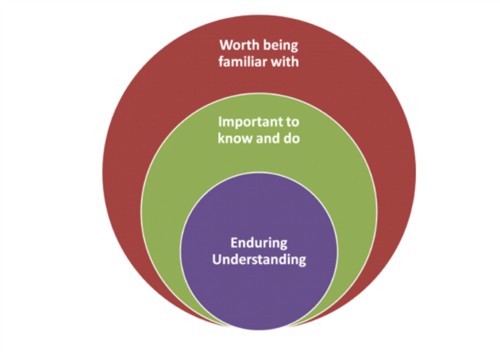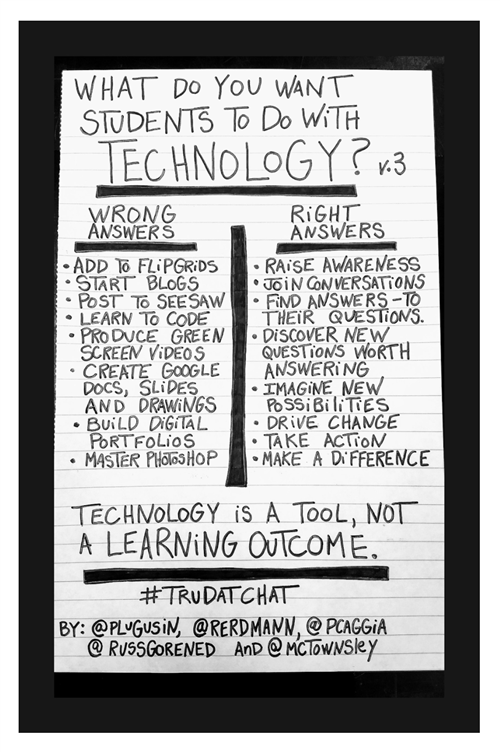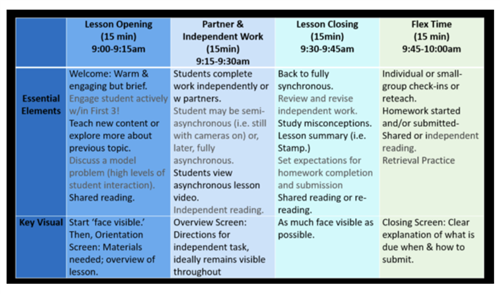- VERONA PUBLIC SCHOOLS
- Remote Teaching & Learning: Best Practice Tips for Making it Work
-
Curriculum“Regular” teaching and learning has been severely disrupted by this pandemic. We all know this to be an obvious truth. Part of that chaotic disruption has been to our curricula and to how many standards we can and should reasonably teach when faced with drastically reduced student contact time and overall instructional minutes.Some key questions to reflect upon:
- How do I declutter and “Marie Kondo” my curriculum?
- What are nonessential standards I can let go of?
- What are essential standards that must be taught?
- What would your colleague in the grade above you say is most essential for students to learn?
- What content and which skills are “need to have”? Which are merely “they’d be nice to have?”
 “The key idea is to just focus on the essential knowledge and skills that kids need to learn in a given year, and then let go of some of the rest.” - Professor Jal Mehta, Harvard Graduate School of EducationReference Materials:
“The key idea is to just focus on the essential knowledge and skills that kids need to learn in a given year, and then let go of some of the rest.” - Professor Jal Mehta, Harvard Graduate School of EducationReference Materials:- Agonizing over school reopening plans? Think Marie Kondo
- Power Standards
- Take back the standards: A modest proposal for a quiet revolution
Question: What criteria should I reflect upon when determining the power standards for my course or grade level?- Endurance - the standard is relevant enough to “stick” across many grade levels and years.
- Ex: Providing specific, textual evidence to support a claim
- Leverage - the standard is important and useful in multiple subject areas.
- Ex: Constructing evidence-based arguments
- Vertical articulation - what knowledge and skills are most important for students to have for the next grade level?
- Ex: A grade 3 math teacher asks a grade 4 math teacher: “What essential concepts/skills do my students need to know for next year?” The grade 4 teacher response could be the following:
- “For the first unit of instruction, please focus on number patterns from chapter 1 (grade 3), and word problems and two-step word problems with addition and subtraction from chapters 2 and 3.”
- “If you have extra time, please focus on place value and the number line in chapter 1 and mental addition and subtraction and estimating sums and differences in chapters 2 and 3.” There are several other additional clusters that can be taught, but focusing on patterns, addition and subtraction with word problems is what is essential for these three units.”
InstructionWe have all been asked to adapt greatly while transitioning from business as usual to business that is most unusual. This is certainly true in the area of pedagogy. Not everyone has a rich background or a wealth of experience as an intentional, online educator. So, while we need to shrink our curricula, we also need to continue to work to improve the overall quality of remote teaching and learning. To this end, we might migrate over some best practices that translate nicely from the brick and mortar classroom to a virtual classroom. However, we are also challenged to learn and practice new strategies and technologies that could improve teaching and learning in a fully remote or hybrid environment.Some questions to reflect upon:- What are a few ed tech tools that can actually improve teaching and learning?
- How will you establish your classroom expectations and norms for distance learning?
- How will you focus on building a sense of community and positive relationships online with students who are new to you?
- How can you motivate and engage students in remote learning?
- How might you “flip your classroom,” whereby what might have once been done in class can be done at home and vice versa?
- Ex: In a history class, I receive direct instruction from watching a video segment as homework, freeing us up to engage in document analysis activities and document-based discussions during virtual class.
- What are some ways we can pivot from crisis remote learning to more purposefully planned remote teaching & learning?
“All of those things that we know are really good practices can still be done virtually...It just might look a little different.” - Melanie Kitchen, Coordinator of Instructional technology & Staff Development, New York Darryl Williams’ Framework for Online Lessons - a way of structuring a remote lesson and preserving the gradual release of responsibility, mixing some direct instruction with independent practice and work time.
Darryl Williams’ Framework for Online Lessons - a way of structuring a remote lesson and preserving the gradual release of responsibility, mixing some direct instruction with independent practice and work time. AssessmentWe should look to continue with a robust system of formative assessment (assessment for learning) during hybrid or remote instruction. Formative assessment is the engine that drives feedback and it is a teacher’s feedback that helps each and every student improve his or her performance. Feedback also takes the form of data or information that teachers can use to adjust their own instruction (reteach, try a different method, provide targeted support to certain students, etc.) Grades are primarily (but not exclusively) derived from summative assessments (assessments of learning) that take place at the end of a unit of instruction and should constitute our Stage 2 transfer tasks in our UbD curricula.Some questions to reflect upon:
AssessmentWe should look to continue with a robust system of formative assessment (assessment for learning) during hybrid or remote instruction. Formative assessment is the engine that drives feedback and it is a teacher’s feedback that helps each and every student improve his or her performance. Feedback also takes the form of data or information that teachers can use to adjust their own instruction (reteach, try a different method, provide targeted support to certain students, etc.) Grades are primarily (but not exclusively) derived from summative assessments (assessments of learning) that take place at the end of a unit of instruction and should constitute our Stage 2 transfer tasks in our UbD curricula.Some questions to reflect upon:- How do you formatively assess students remotely and how can we get them to really use teacher feedback anchored in these 3 areas:
- Where am I going as a learner?
- What do I need to do to go there?
- What am I going to do to help myself get there?
- How can you allow for students to provide you with feedback on their remote learning experiences?
- What summative assessments can be given that promote student voice and choice, while enhancing assessment security? What can students research, present, create, perform, etc?
- What are questions we can ask and problems posed that students cannot easily “google”?
- How might we sacrifice breadth of learning so that we may gain depth of learning? (See Curriculum recommendations above)
“Formative evaluation shouldn’t be done only so the teacher can make decisions (that’s important) but also so the student can make decisions.” (Fisher, Frey and Hattie, 2020)Reference Materials:- 60 Non-Threatening Formative Assessment Techniques
- David Berliner Blog Post: “The Required Curriculum vs. the Not Required Curriculum”
- 9 Ways Online Teaching Should Be Different from Face-to-Face (Focus on #9)
- Student-created products of learning
HomeworkHomework remains one of the more hotly contested topics in a profession with no shortage of them. That said, some of the more recent research in this area reveals that there is little to no academic value to homework that is more than an hour at the middle school level (all classes combined) and a maximum of two hours (all classes combined) in high school.Due to these findings, many schools have worked to reduce the amount of homework given on a daily basis, the overall grade value placed on homework and to give serious thought to the degree that homework promotes meaningful learning.Some questions to reflect upon:- What is the purpose of assigning homework? When is it truly necessary?
- When homework is given, how can it be reasonable and meaningful work worth doing and not “busywork”?
- How can rigor be reconceived? Is it more rigorous to assign 30 math problems at home or 5 challenging ones?
- How might homework assignments be designed and assigned with student input and involvement?
“Teens after all are becoming. They are forming their identities, values and views of the world. They need a balance of intellectual, emotional, and dare I say, spiritual experiences to help them grow into happy and well-adjusted adults, not just to prepare them to be college students.” - Cathy VatterottReference Materials:

